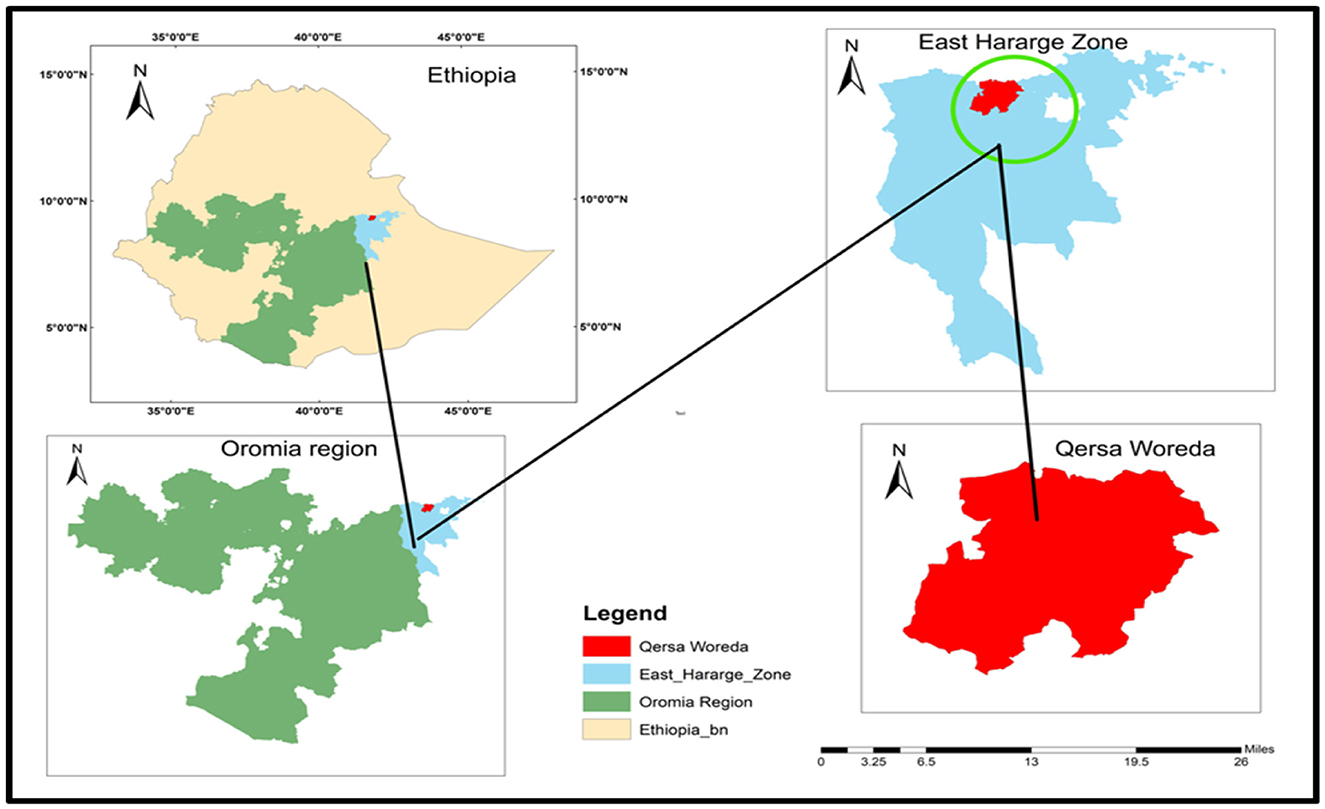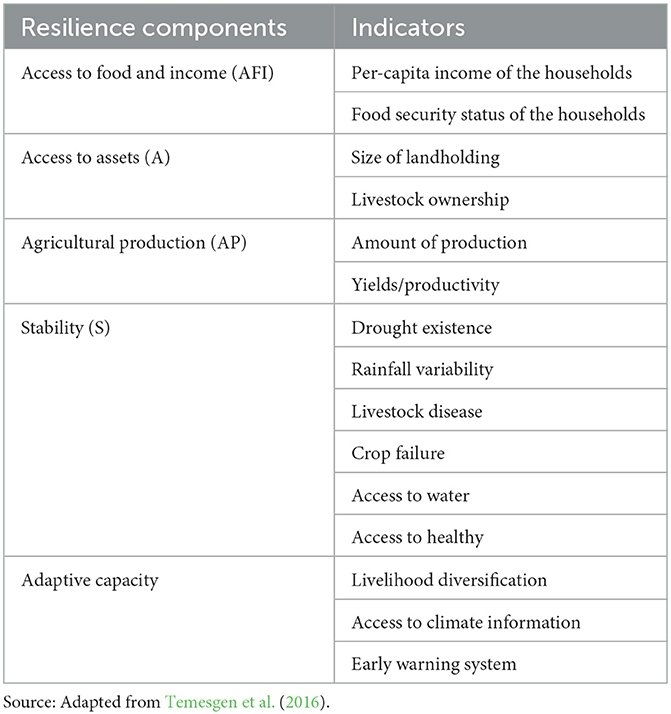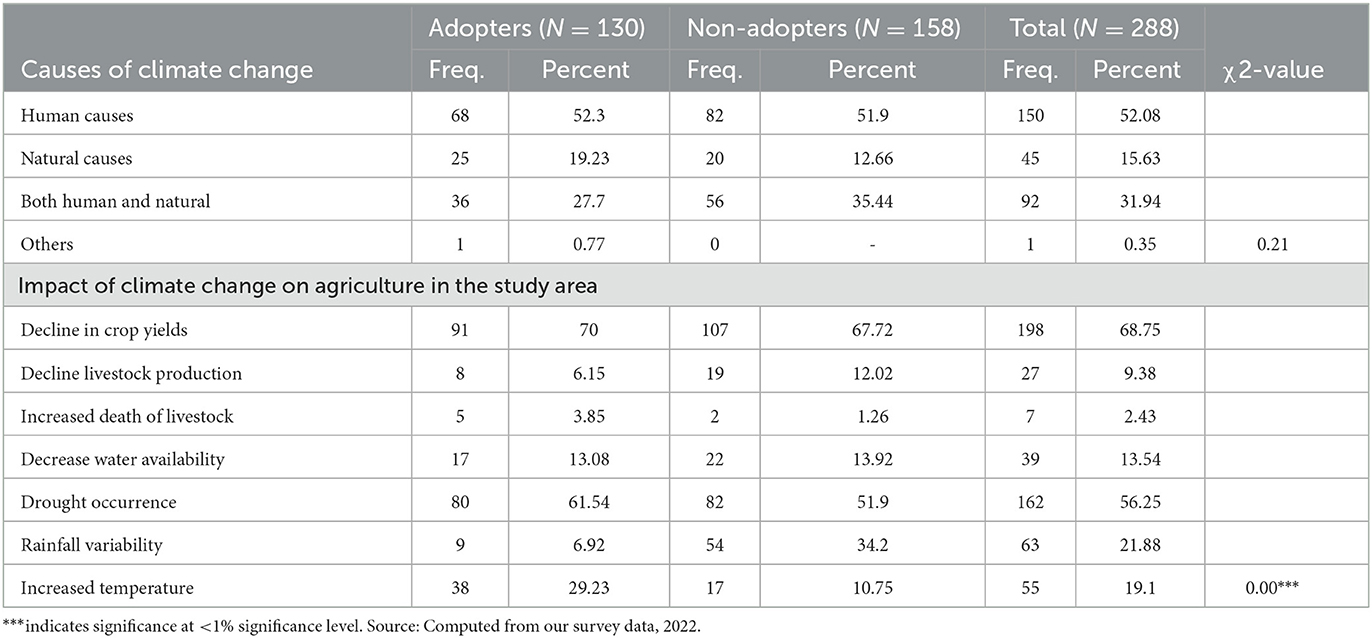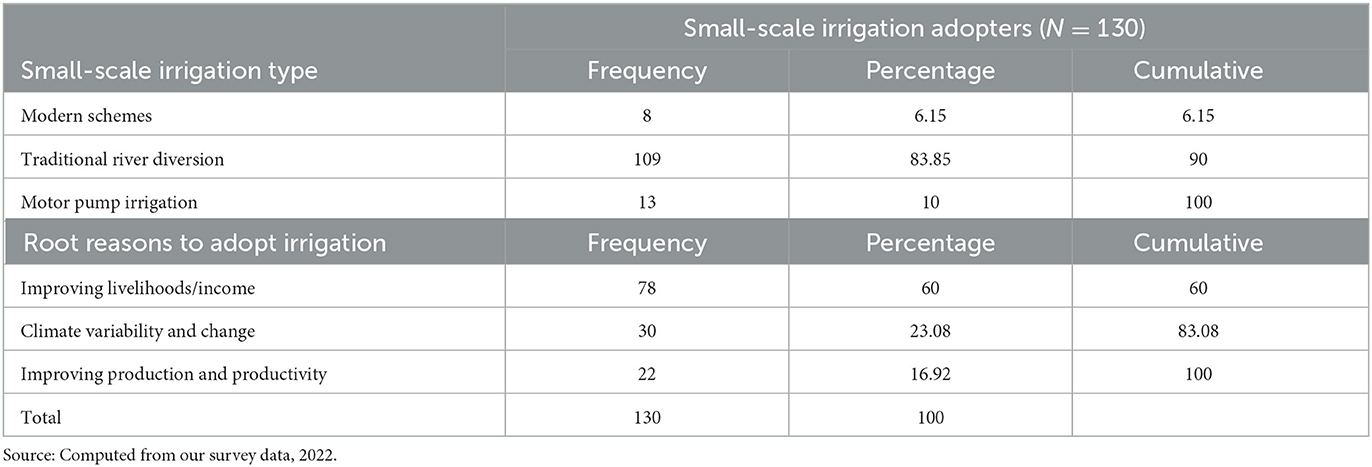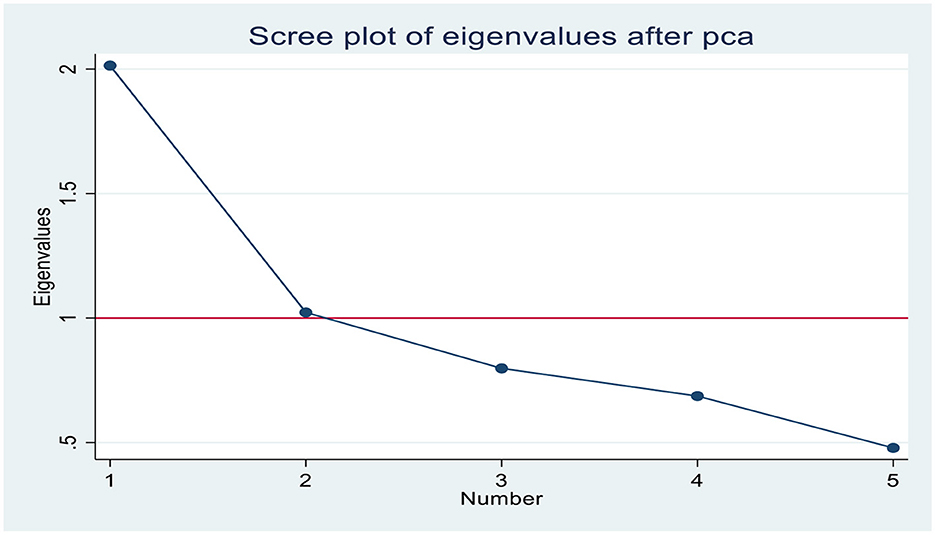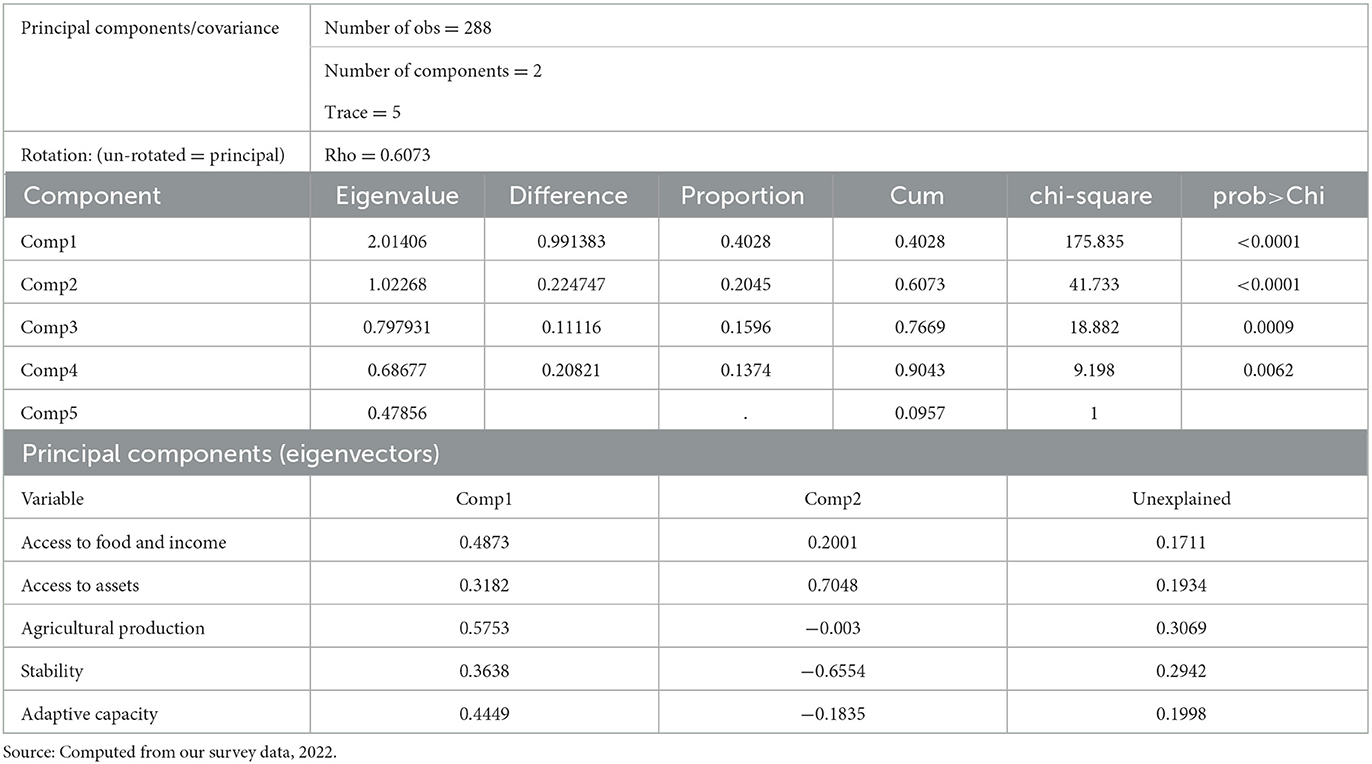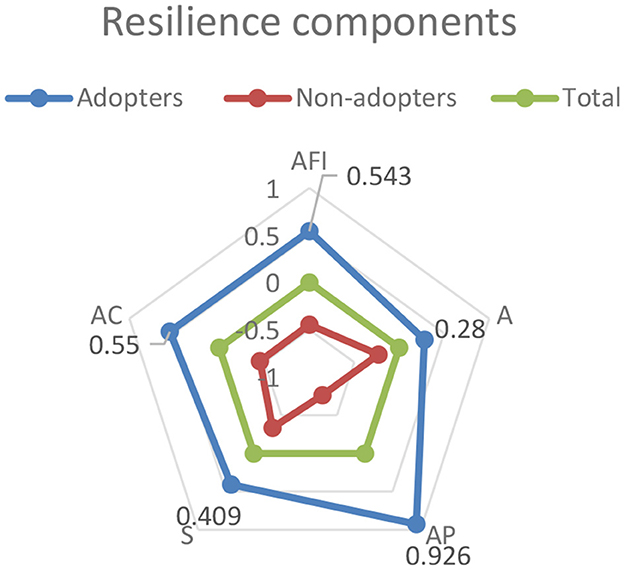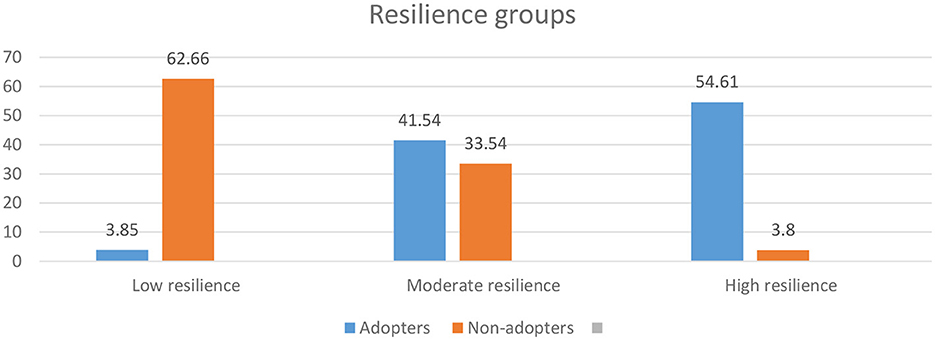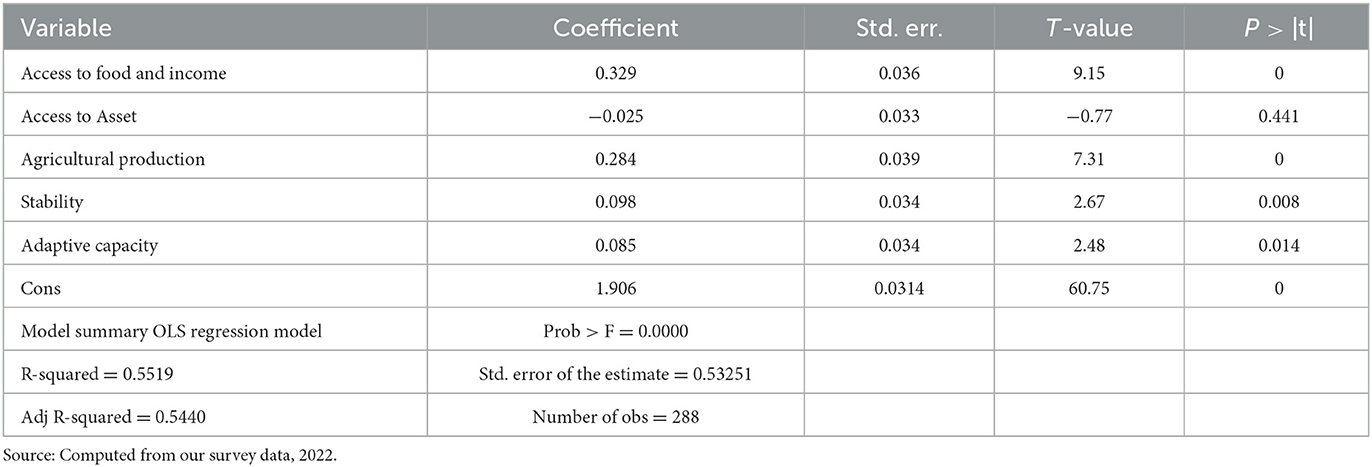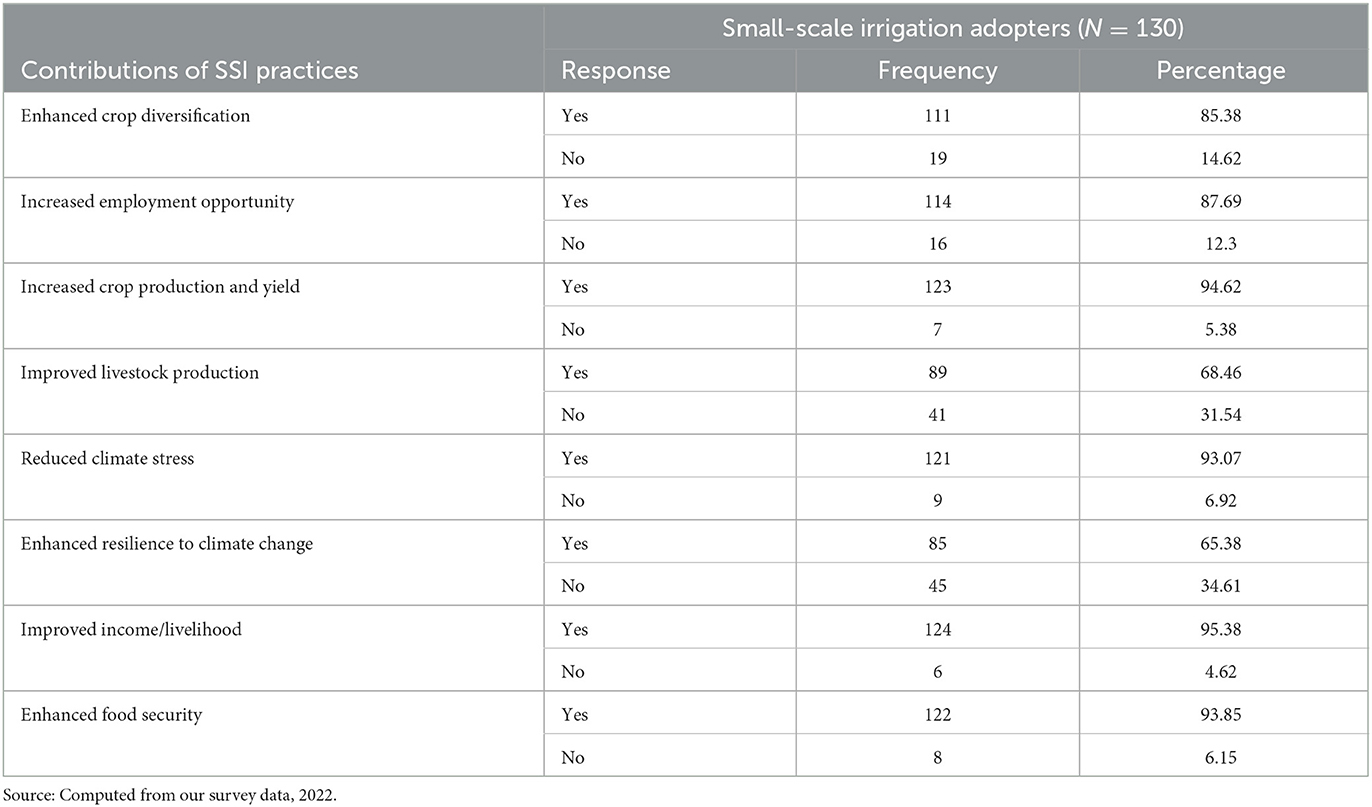- 1Oromia Agricultural Research Institute, Asella Agricultural Engineering Research Center, Asella, Ethiopia
- 2School of Agricultural Economics and Agribusiness, Haramaya University, Dire Dawa, Ethiopia
This study surveys farmers in the Kersa district, East Hararghe zone, Oromia regional state, Ethiopia, to assess their adaptability and their perceptions of the role of small-scale irrigation in improving resilience to climate change. Data were collected from a sample of 288 randomly selected households (130 adopters and 158 non-adopters of small-scale irrigation). A household survey was used to gather quantitative data, and qualitative data were collected through focus group discussions and key informant interviews. Data were analyzed using principal component analysis to generate the resilience capacity index of the households. Analysis revealed that adopters were better off on all indicators of resilience, including access to food and income, assets, agricultural production, stability, and adaptive capacity. The findings also suggest that households with high resilience are more resilient to climate change. These results suggest that small-scale irrigation increases responsiveness to irregular weather patterns, significantly contributing to increasing farmers' resilience by minimizing the impacts of climate change. Therefore, policymakers should pay due attention to mitigating the impacts of climate change and improving the adaptive capacity of small-scale farmers.
1. Introduction
Climate change has a significant influence on society's wellbeing, particularly that of smallholder farmers (Komba and Muchapondwa, 2018; Abegunde et al., 2019). Climate change adversely influences agriculture and smallholder farm households in developing countries (FAO, 2019). Due to their economies' overdependence on climate-sensitive sectors, developing countries are the most susceptible to climate change (AGRA, 2018; IPCC, 2018). Most smallholder farmers based their livelihoods on rainfall agriculture, which is climate-sensitive and more susceptible to the effects of climate change than any other sector (Mikulewicz, 2018; Asfaw et al., 2021). In countries such as Ethiopia, where agriculture depends primarily on rainfall, temperature increases as well as rainfall variability make agriculture more vulnerable to climate change (Tadesse and Alemayehu, 2017).
Farmers' responses to climate change to sustain food security in terms of agricultural production losses that are aggravated by climate change vary from place to place and among smallholder farmers (Woldegebrial et al., 2015; Abegunde et al., 2019). Several strategies have been proposed to improve the livelihoods of smallholder farmers. The Ethiopian government has launched the Climate-Resilient Green Economy (CRGE) program to safeguard the country from climate change's adverse effects and develop a green economy that will help Ethiopia achieve its goal of becoming a middle-income country by 2025. One of the pillars of the CRGE program is improving agricultural production systems to achieve food security and increase farmers' income, thus enhancing resilient and climate change adaptive systems (FDRE, 2011).
Building climate change resilience in farming systems can ensure that livelihoods depend on the system of concern and lessen their vulnerability to the effects of climate change and regular climate variability (Singh et al., 2022). Resilience provides a perspective on how to recognize and examine the various components, indicators, practices, and strategies that enable production systems to be restrained and overcome the consequences of variability and change (Bahadur et al., 2015). To increase their resilience to climate change, rural households implemented several adaptation strategies (Keshavarz and Soltani, 2021).
The adoption of climate-smart agricultural practices plays a vital role in increasing farmers' resilience to climate variability and climate change (Tewodros, 2018; Chaltu, 2021). Climate-resilient agriculture protects food security and improves the livelihoods of smallholder farmers (Gugissa et al., 2022). Climate-resilient households are those that, despite any instant setbacks, are successfully adopting climate-smart agriculture practices and working their way out of poverty and vulnerability in the long run (Gutu, 2017; Keshavarz and Soltani, 2021). Farming system improvements through the adoption of climate-smart agriculture practices are critical for achieving climate resilience and increasing sustainable rural livelihoods (Rathi, 2020).
Smallholder farmers are especially vulnerable to the effects of climate change (Makuvaro et al., 2018). As a result, small-scale irrigation (SSI) and other practices of agricultural water management are a concern for the livelihood of smallholder farmers. These practices ensure sufficient availability and reliable access to water and assist these farmers to withstand climate change. Farmers may become less vulnerable by implementing climate-smart agriculture practices such as small-scale irrigation (Mango et al., 2018). Small-scale irrigation helps to stabilize agricultural production, mitigate the adverse effects of climate change and climate variability, and increase farmers' resilience (Abdissa et al., 2017). It increases the resilience of farmers to the influences of climate change by increasing agricultural production and assets (Menasbo, 2021) and through sustainable food production and environmental health (Alefu et al., 2022). Farmers have stated that irrigation increased their net income, served as protection against reduced rainfall, and provided protection from rising temperatures (Asmera and Yidnekachew, 2021).
In Ethiopia, the irrigation potential is estimated to be approximately 5,536,457 hectares of land, with only 4,256,457 hectares irrigated thus far, while in Oromia, out of a total of 1.7 million hectares of irrigable land, only 1,350,000 hectares have been irrigated thus far, using both traditional and modern irrigation schemes (Belachew et al., 2022). The Kersa district has a variety of rivers and streams that are suitable for small-scale irrigation. More than 5,071 hectares of land in the district have the potential to be irrigated, but only 2,704 hectares of that total have been cultivated under various irrigation schemes (KDANRO, 2020).
Despite the potential of small-scale irrigation practices as an adaptation strategy for climate change in the study area, there is little empirical data on the resilience of farm households against the impact of climate change, and on the perceptions of farmers on the role of small-scale irrigation to improving resilience. Therefore, the present study was recognized as an attempt to answer the following question: “How resilient are farmers against the impact of climate change? Do small-scale irrigation practices improve the resilience of farmers against the adverse effects of climate change? How do households perceive the contribution of small-scale irrigation to improving their resilience to climate change stress?”
2. Research methodology
2.1. Study area
The Kersa district is one of the districts in the East Hararghe zone, Oromia National Regional State, Ethiopia. It is located 478 km east of Addis Ababa, the capital city of Ethiopia (Figure 1). The district has approximately 199,601 residents, the majority (93.8%) being rural residents, while urban residents account for only 6.2% of the district's population (KDANRO, 2020). Of the total population of the district, 101,796 are men and 97,805 are women. The agroecology of the district is categorized as midland (74%), highland (20%), and lowland (6%). The annual rainfall of the district ranges from 1,658 mm to 830 mm, and the temperature ranges from 30°C to 10°C. The farming system of the district is mainly subsistence farming based on mixed farming, with rain-fed and irrigation agriculture being the most important activities. Cereal crops are sorghum, maize, wheat, barley, and pulses. Khat and vegetables are cash crops. Cattle, goats, and sheep are livestock reared. Wealth status is determined by land size, livestock, and other assets.
2.2. Data types, sources, and methods of data collection
Both primary and secondary sources were used to gather the data. A semi-structured questionnaire, focus group discussions, and key informant interviews were used to collect primary data from the sample households. One focus group discussion involving six to ten participants, both men and women, was held in each selected kebele to gain more insight into the role of small-scale irrigation practices on the farmers' resilience to climate change stresses, as well as perceptions of small-scale irrigation practices. The semi-structured questionnaires were centered on the farmers' perceptions of climate change, their use of small-scale irrigation techniques, socioeconomic factors, institutional factors, and other pertinent information that influences their practices and decisions related to adaptation. Secondary data were gathered from Kersa District Office of Agriculture and Natural Resources records, journals, and other relevant sources.
2.3. Sampling procedures and sample size determination
For this study, a three-stage sampling method was employed. In the first stage, the Kersa district was selected purposively from the East Hararghe zone because the district is one of the areas that is considered to be highly vulnerable to problems caused by climate change, such as rainfall variability and drought. Furthermore, the district has significant experience in adopting small-scale irrigation. In the second stage, among the total 35 rural kebeles of the district, four kebeles were selected randomly from 12 potential small-scale irrigation practices. In the third stage, households were stratified into irrigation users and non-users from the selected kebeles, and then simple random sampling was used to select 288 sample households based on probability proportional to size. Of the total sample households, 158 were non-adopters, whereas 130 were adopters of small-scale irrigation (Table 1). According to proportional sampling, samples from each kebele were selected, and the proportion of each sample to the population in each kebele was determined using the following (Bowley, 1925) formula:
Where, niis the sample to be selected from the ith kebele and Ni is the total population living in the ith kebele. ∑ Ni, Summation of the population in four selected kebeles; n, total sample size for the district.
2.4. Methods of data analysis
Thematic analysis methods were used to examine qualitative data collected through key informant interviews, focused group discussions, and observations. Theme categories were used to clean, review, organize, code, and categorize the qualitative data records from the focus group discussion and key informant interviews. To summarize, present, and interpret survey findings regarding demographic, socioeconomic, and institutional factors, quantitative data were analyzed using descriptive statistics such as the mean, standard deviation, minimum, maximum, percentage, and frequency distribution. To determine the statistical significance level, inferential statistics such as the chi-square test and t-test were used. For the analyses, STATA software version 17 was used.
2.4.1. Measurement of households' resilience to climate change stresses
The Resilience Capacity Index (RCI), which was developed by Bewket et al. (2015), was used to estimate how resilient households are to climate change. The RCI systematically compares resilience across households. Hence, because the resilience indices do not have clearly defined weights, principal component analysis (PCA) was used to assign appropriate weights to the various indicators. The RCI was used to condense the various resilience dimensions into a single statistic.
In the present study, the resilience index for households was calculated using a two-stage method. Using PCA and 15 indicators, five major resilience blocs were first estimated (Table 2). In the second stage, the resilience index was computed from the result of the first stage. The resilience capacity index was estimated from the anticipated resilience blocs. These blocs were access to food and income, assets, agricultural production, stability, and adaptive capacity. The resilience index of specific households was calculated using principal component analysis and the factor method based on the factor loading of each indicator.
In mathematical representation, the resilience index is denoted as a function of the blocs as follows:
Where, Ri is the resilience index, AFI is access to food and income, A is assets, AP is agricultural production, S is stability, and AC is adaptive capacity. Hence, the resilience index is the weighted sum of the factors generated and specified as:
Where, Wj is the weight of variable j and Fj is the factor under consideration of variable j. The weights are the proportions of variance explained by each factor.
Similarly, estimating the resilience of households also depends on absorptive, adaptive, and transformative capacities (Mengistu et al., 2019). Relevant variables under each major component category were collected from different published studies. Based on that, to access the resilience capacity of the households, 15 major components for different farming systems were identified as resilience capacity indicators under three capacities.
Absorptive capacity refers to the ability to cope with disturbance without entirely disintegrating and to return to a functional state (Gutu, 2017). It is mainly useful for protecting against immediate disturbances as well as in the early stages of dealing with massive climatic shocks (Darnhofer, 2014; Singh et al., 2022). The total absorptive capacity provides stability to the system against the adverse impact of climate change on individuals, households, communities, and authorities. For this study, absorptive capacity, including drought existence, rainfall variability, livestock diseases, crop failure or yield decline, access to early warning systems, and receiving climate information, were identified as the major indicators.
Adaptive capacity helps the community to make suitable changes to better manage or amend changing conditions (Mengistu et al., 2019). A key aspect of adaptive capacity is flexibility, continuous adjustment, learning, and innovation. In the present study, the variables included under adaptive capacity were access to food, per capita income, cultivated land size, livestock ownership, agricultural production, and yields of major crops.
Transformative capacity is about fundamental changes in the structures and function of the system with the sharing of risk within societies and the global community (Frankenberger et al., 2013; Gutu, 2017). The selected indicators under the transformative capacity included health services, access to water sufficiency, and livelihood diversification.
Resilience capacities are interrelated and mutually reinforcing at multiple levels (individual, household, community, district, national, and regional). Building resilience, therefore, necessitates involvement that encourages absorptive, adaptive, and transformative capacities at several levels (Mengistu et al., 2019).
2.4.2. Determining the importance of latent dimensions of household resilience
It should be noted that not all latent measurements consistently affect household resilience. Even though certain consequences are more severe than others, all of them matter for assessing resilience. Using the ordinary least squares technique, a simple regression analysis was conducted to determine the impact of each latent variable on household resilience. Five of the latent factors were employed as explanatory variables, while the scores for household resilience were used as the dependent variable. Before running the model, multi-collinearity was checked. Thus, all the latent variables had no issues with multi-collinearity between the variables. The empirical model used to predict household resilience is as follows:
Where, RCI is household resilience; ∂ is a constant; β1 to β5 are the coefficients of each variable; and ε is an error term signifying the slight evidence of the variables used to estimate resilience. The R-squared value designates how much of the entire disparity in the RCI can be enlightened by AFI, A, AP, S, and AC.
3. Results and discussion
3.1. Farmers' perception of climate change
According to the study results, 52.08% of respondents said that human activity that led to the deforestation of natural resources was responsible for climate change, while 15.63% said that natural causes were responsible, and 31.94% said that both natural and human causes were responsible. Similar responses from those who adopted small-scale irrigation indicated that human activity (52.3%), natural (19.23%), and both activities (27.7%) were responsible for causing climate change. Non-adopters also mentioned human causes (51.9%), natural causes (12.66%), and both natural and human causes (35.44%) (Table 3).
The findings further showed that climate change has its own consequences. The main consequences perceived by households were a decline in crop production (68.75%), a decline in livestock production and increased death of livestock (11.81%), and a decrease in water availability (13.54%). Moreover, the community perceived that drought was the consequence of climate change and that there was frequent drought occurrence (56.25%), rainfall variability (21.88%), and increased temperatures (19.1%) from season to season due to climate change (Table 3). The opinions expressed during the focus groups showed that farmers' livelihoods were adversely affected by climate change and that climate change decreased water availability and affected crop and livestock productivity.
The results also indicated that approximately 29.23% of small-scale irrigation adopters and 10.75% of non-adopters perceived increased temperatures because of climate change. The Pearson chi-square test revealed a significant difference between the perceptions of adopters and non-adopters on increased temperatures and their effects at less than a 1% significance level. This illustrates an increasing temperature trend in the area. This was in line with the findings by Desalegn and Filho (2017) and Seyoum (2018), who reported that smallholder farmers perceived local climate change through soil erosion, loss of soil fertility, reduction in agricultural production and productivity, and frequent occurrence of droughts (Table 3).
3.2. Small-scale irrigation practices and their sources in the study area
According to data from focus group discussions and agricultural office reports, small-scale irrigation practices have a long history in the study area. Farmers often engage in small-scale irrigation activities to lessen the effect of climate change. In response to climate change stresses, they adopt small-scale irrigation techniques to grow various crops in an effort to enhance production. Farmers' increased cropping intensity and crop diversification due to the expansion of small-scale irrigation practices increase agricultural productivity.
The adoption of small-scale irrigation has significantly increased in the area recently, and farmers' cropping patterns have evolved from relying mostly on the production of field crops to high-value crops. Most farmers practice traditional small-scale irrigation, which involves traditional river diversion in the area. Both traditional and modern small-scale irrigation systems are currently in use in the study area. A few farmers have adopted modern small-scale irrigation, such as canal river diversion, and irrigation technologies such as motor pumps. The results revealed that out of the total small-scale irrigation adopters, 83.85% used traditional river diversion, whereas 10 and 6.15% used motorized water pumps to divert irrigation water and modern small-scale irrigation river diversion, respectively (Table 4).
According to data from focus group discussions, key informants, and field observations, the main sources of small-scale irrigation practices were rivers, springs, and underground water in the study area. Most of the small-scale irrigation users irrigated their crops by direct furrow from the local river (90.76%), followed by motor pumps (8.46%). Mostly, they irrigated vegetables and khat. The results revealed that the essence of using small-scale irrigation was improving livelihoods/income (60%), climate variability and change (23.08%), and diversification and intensification of crop varieties for improving production and productivity (16.92%) (Table 4). This suggests that small-scale irrigation has a significant role in the adaptive capacity of irrigation users to adapt to climate change, in addition to enhancing production and income, which leads to increased farmer resilience and also diversifies sources of livelihood.
According to the study, approximately 61.53% of small-scale irrigation adopters produce crops at least twice annually, while 38.46% produce crops three times annually. The non-adopting households only have one opportunity to grow crops using rain. The result also illustrates a significant difference in cropping intensity between the two groups at <1% significance level. This suggests that adopters are better off in terms of crop production and yield, thus improving household incomes and enabling them to better adapt to climate change and climate variability. This result was in line with Woldegebrial et al. (2015) and Abebe (2019).
3.3. Measuring farm households' resilience to climate change stresses
3.3.1. Estimation result of the resilience capacity index
The overall resilience index was estimated using principal component analysis and factor analysis. The results showed that the model's Kaiser–Meyer–Olkin (KMO) statistic was 0.6704, which is adequate for factor analysis. The resilience capacity index can be successfully written as RCI = 0.4028 *comp1 + 0.2045 *comp2. The PCA based on the resilience blocs created two potential components on the scree plot (Figure 2), contributing to a cumulative variance of 60.73% with an eigenvalue cutoff of 2.0 (Table 5).
The results showed that all the indicators in comp1 were positive and significantly related to the resilience of the households. Except for access to food and income and access to assets, all the remaining components were negatively correlated with the resilience of households in comp2. This implies that among the blocs of households' resilience, AP, S, and AC were negatively related to the second component. It is clear that inefficient agricultural production, instability, and a lack of adaptive capacity make households more susceptible to shocks and worsen their standard of living, especially in the case of food insecurity due to climate change. In the second component, access to food and income and access to assets became positive, indicating that it is a positive characteristic of household resilience. This is likely expressed in terms of the food security and vulnerability situations of households. Agricultural productivity, stability, and adaptability are all positive in the first component but negative in the second.
As a whole, agricultural production in comp1 and access to assets in comp2 were the most significant contributors to household resilience, while, in the first component, access to food and income was also a key factor supporting households' resilience to shocks brought on by climate change. Additionally, it is impossible for household resilience estimation to be one-dimensional, and the result displays the principal component that takes into account two components. For instance, asset holding, which reflects the welfare of households, was the most crucial factor in the resilience of smallholder farmers. As a result, each of the resilience blocs helps households become more resilient to the effects of climate change. To increase farmers' resilience to adverse impacts, factors such as income and food access, production, adaptive capacity, stability, and assets should be given top consideration. The eigenvalue results revealed a significant difference between different components of household resilience at p < 0.01 probability levels. This result is in line with the conclusions of Temesgen et al. (2016) and Mengistu et al. (2019).
The resilience capacity index and the household resilience analysis for adopters and non-adopters of small-scale irrigation farming showed that there was a significant difference among the household resilience indicators. Hence, the adopters were better off in all resilience indicators, including access to food and income, assets, agricultural production, stability, and the adaptive capacity of the households (Table 6). This shows that each resilience dimension influences how much the level of resilience has improved.
The RCI between small-scale irrigation adopters and non-adopters ranges from −2.389 to 3.908, with a mean between −1.053 and 1.280 (Table 6). This finding shows that adopters of small-scale irrigation had a resilience index that was significantly higher than that of non-adopters. Moreover, the result also implies that households whose resilience capacity was negative were non-adopters, while those with positive values were adopters of small-scale irrigation. The adopters had a higher level of resilience, whereas the non-adopters had a low level of resilience against climate change stress in the study area.
The results also showed a significant difference between the two groups in terms of the households' resilience capacity index at a significance level of less than 1% (Table 6). As a result of adopting small-scale irrigation practices as a climate change adaptation strategy, adopters increased their resilience to climate change when compared to non-adopters. This result is consistent with the findings of Menasbo (2021) and Abdissa et al. (2017), who showed that small-scale irrigation improves the resilience of smallholder farmers against climate change stresses.
A radar graph (Figure 3) depicts the results of the major resilience component estimations for the two groups. At the web's center, the diagram's scale is −1 (less resilient), and it rises to 0.5 (more resilient). Figure 3 shows that adopters of small-scale irrigation are more resilient in all resilience components than non-adopters, especially in terms of agricultural production. Moreover, the non-adopters have the worst situation of resilience in terms of agricultural production.
3.3.2. Resilience capacity of the households in terms of three capacities
The results also showed that high-resilience households had a more adaptive capacity in response to climate change and climate variability. Furthermore, the high-level resilience farmers had higher mean values of adaptive capacity than the farmers with moderate and low levels of resilience and low mean values of transformative capacity (Table 7 and Figure 4). The high mean value of adaptive capacity could be explained by the fact that indicators of adaptive capacity, such as access to food and income, good agricultural production, and assets, benefited farmers in better adapting to climate change and improving their livelihoods by using diverse adaptation strategies such as irrigation. The opinions voiced in the focus group discussions were in line with the survey results. In comparison to non-adopters, households that have diversified their livelihoods by using small-scale irrigation generate more income, produce more food, and are better off financially. The studies by Gutu (2017), Mengistu et al. (2019), and Chaltu (2021) found similar results.
3.3.3. Households' Resilience levels to climate change
The resilience of households was classified as low, moderate, and high resilience. Out of the total adopters, 54.61% of them were in highly resilient groups, whereas only 3.85% of non-adopters were in highly resilient groups (Figure 5). The adopters' households could be mainly characterized by their significantly larger capacity to respond to the serious problems posed by climate change as well as their significantly higher willingness to use climate-smart technologies, such as small-scale irrigation techniques, to continue carrying out their normal activities under climatic stress. The highly resilient smallholder farmers in the study area were also less likely to migrate in the hopes of finding better agricultural practices.
The findings showed that 62.66% of the non-adopter households fell into the low resilience classification, whereas only 3.85% of adopters were low resilient households (Figure 5). The increased susceptibility to the negative effects of climate change and the decreased capacity to mitigate the disruptive effects were the main traits of the low-resilience households. They found that the losses brought on by climate change offered little motivation to continue farming, which moved them to work hard at off-farm activities or relocate from rural to urban areas in an attempt to increase their income and create sustainable means of livelihood. Additionally, the findings indicated that 33.54% of non-adopters and 41.54% of adopters' households were both categorized as moderately resilient. These farming households had a moderate capacity to reduce their susceptibility to the effects of climate change, as well as a moderate vulnerability to those effects.
3.3.4. Relative importance of the latent dimensions of household resilience
The results showed that household resilience was most strongly correlated with access to food and income. According to the findings, a 0.329-unit increase in access to food and income correlated with a one standard deviation advance in that household's resilience (Table 8). A 0.284 unit increase in agricultural production led to a one standard deviation increase in household resilience. This is because household resilience to climate change was positively correlated with access to food, income, and sustainable agricultural practices. The variables significantly influenced the resilience of the households. This indicates that when technology is adopted, income and production increase, and household individual resilience increases.
Moreover, a positive coefficient was used to describe stability and adaptability, including access to food and income as well as effective agricultural practices. As a result, an increase of 0.098 and 0.085 units in stability and adaptive capacity resulted in a one standard deviation improvement in household resilience (Table 8). The findings showed that as stability and adaptive capacity increased, households' resilience to the stress of climate change increased as a result of increased knowledge about the weather and more diversification in their sources of income. This outcome was consistent with the results of Dhraief et al. (2019) and Mengistu et al. (2019).
3.4. Households' perceptions of the role of small-scale irrigation in improving resilience to climate change
Smallholder farmers must use small-scale irrigation to enhance agricultural productivity and improve their resilience to diverse climate change challenges. The findings showed that 95.38% of respondents claimed that small-scale irrigation practices increased their income and livelihoods, whereas only 4.62% responded that there had been no change in their income and livelihoods. Food security was increased due to the adoption of small-scale irrigation, with 93.85% of the adopter farmers responding that there was incremental food security status through an increase in agricultural productivity. The results revealed that 68.46% of the sample respondents claimed that small-scale irrigation contributed to improving livestock production and its byproducts (Table 9).
According to the study, the majority of farmers stated that small-scale irrigation played a significant role in increasing agricultural production. Only 5.38% of respondents disagreed with the statement that small-scale irrigation practices increased crop production and yield. In addition, 85.38% of respondents revealed that, due to irrigation to increase agricultural outputs, there was crop diversification. Thus, in the study area, small-scale irrigation allows farmers to produce higher-value agricultural products, especially vegetable production. Small-scale irrigation has also made a significant contribution to the creation of job opportunities. In rural areas, different labor is required for land preparation, weeding, chemical application, watering, harvesting, and transportation. As a result, small-scale irrigation has not only increased agricultural production and productivity but has also created job opportunities for farmers.
The findings also revealed that 93.07% of the sampled respondents indicated that small-scale irrigation adoption reduces climate risk by increasing responsiveness to unpredictable weather patterns and improving resilience to climate change stresses (65.38%) (Table 9). Thus, adopting small-scale irrigation increases productivity and farmers' resilience to climate change stresses. This finding is similar to the results of Adebayo et al. (2018), Abel (2019), Yeshambel (2019), Demsew and Ermias (2020), and Asmera and Yidnekachew (2021), who showed that small-scale irrigation has a significant influence on the livelihood and resilience of smallholder farmers.
4. Conclusion and recommendations
This study aimed to assess how resilient farm households are to climate change and analyze their perceptions of the contribution of small-scale irrigation practices in improving resilience to climate change stresses in the Kersa district, Oromia, Ethiopia. A three-stage sampling method was used to collect cross-sectional data from a sample of 288 households in four randomly selected kebeles. For the analysis, both quantitative and qualitative data were collected. The data were analyzed using principal component analysis and factor analysis.
The results revealed that all the dimensions improved resilience to shocks caused by climate change. The adopters benefited better in terms of all resilience indicators, such as household stability, access to assets, access to food and income, agricultural production, and adaptive capacity. This shows that each resilience dimension contributes to the level of improvement in the resilience of households. The findings also showed that the most important factors influencing households' resilience to shocks posed by climate change were access to assets on comp2, efficient agricultural production, and access to food and income on comp1. The result indicates that households with negative values for resilience capacity were non-adopters, whereas those with positive values were adopters. In the study area, adopters had higher levels of resilience than non-adopters when it came to coping with the effects of climate change. This revealed that adopters are more resilient to the stresses of climate change. The results also showed that high-resilience households have a more adaptive capacity in response to climate change and climate variability. Moreover, the high-level resilience farmers have higher mean values of adaptive capacity than those with a moderate or low level of resilience and a low mean value of transformative capacity.
Finally, the results corroborate that small-scale irrigation adoption enabled smallholder farmers to become more resilient to the effects of climate change by increasing agricultural production and yields through crop diversification and intensification, which improved rural households' resilience. The results further showed the benefits of small-scale irrigation on household resilience in that it enhanced food self-sufficiency, household income sources, livestock production, and employment opportunities in the study area. Small-scale irrigation practices significantly lessen climate-induced shocks by improving the response to erratic rainfall patterns, which, in turn, increases smallholder farmers' resilience to climate change stresses. Therefore, to improve households' resilience and lessen the risks of climate change, all stakeholders should support small-scale irrigation practices as adaptation strategies against climate change. Moreover, to mitigate the effects of climate change, the government and concerned stakeholders should seek to expand and promote small-scale irrigation practices as an adaptation strategy against climate change.
Author's note
Kebele is the lowest administrative unit in Ethiopia.
Data availability statement
The original contributions presented in the study are included in the article/supplementary material, further inquiries can be directed to the corresponding authors.
Ethics statement
Ethical review and approval was not required for the study on human participants in accordance with the local legislation and institutional requirements. Written informed consent for participation was not required for this study in accordance with the national legislation and the institutional requirements.
Author contributions
ID designed the data collection tools, undertook the survey work and most of the analysis, and developed the manuscript. JH and MA contributed to reading and editing the manuscript as advisors. All authors read and approved the manuscript.
Conflict of interest
The authors declare that the research was conducted in the absence of any commercial or financial relationships that could be construed as a potential conflict of interest.
Publisher's note
All claims expressed in this article are solely those of the authors and do not necessarily represent those of their affiliated organizations, or those of the publisher, the editors and the reviewers. Any product that may be evaluated in this article, or claim that may be made by its manufacturer, is not guaranteed or endorsed by the publisher.
References
Abdissa, F., Tesema, G., and Yirga, C. (2017). Impact analysis of small-scale irrigation schemes on household food security in the case of Sibu Sire District in Western Oromia, Ethiopia. Irrigat. Drain. Syst. Eng. 6, 1–7. doi: 10.4172/2168-9768.1000187
Abebe, T. A. (2019). The role of small-scale irrigation in climate change adaptation: The case of East Belesa district, Amhara Region, Ethiopia. MSc Thesis, Hawassa University, Wondogenet, Ethiopia.
Abegunde, V. O., Sibanda, M., and Obi, A. (2019). The dynamics of climate change adaptation in Sub-Saharan Africa: A review of climate-smart agriculture among small-scale farmers. Climate 7, 132. doi: 10.3390/cli7110132
Abel, W. (2019). Impact of small-scale irrigation on smallholder farmers livelihood improvement: In case of Damota Gale district, Wolaita zone, SNNPR, Ethiopia. J. Econ. Sustain. Develop. 11, 23–32. doi: 10.7176/JESD/11-5-04
Adebayo, O., Bolarin, O., Oyewale, A., and Kehinde, O. (2018). Impact of irrigation technology use on crop yield, crop income and household food security in Nigeria: A treatment effect approach. J. Agric. Food 3, 154–171. doi: 10.3934/agrfood.2018.2.154
AGRA (2018). Alliance for a Green Revolution in Africa. Africa Agriculture Status Report: The Business of Smallholder Agriculture in Sub-Saharan Africa. In Nairobi, Kenya.
Alefu, C.h., Bobe, B., Tesfaye, L., Tamado, T., Tilahun, H., and Bisrat, E. (2022). Farmers' perceptions about irrigation roles in climate change adaptation and determinants of the choices to WUE-improving practices in Southern Ethiopia. Air, Soil Water Res. 15, 1–14. doi: 10.1177/11786221221092454
Asfaw, A., Bantider, A., Simane, B., and Hassen, A. (2021). Smallholder farmers' livelihood vulnerability to climate change-induced hazards: agroecology-based comparative analysis in Northcentral Ethiopia (Woleka Sub-basin). Heliyon. 7, e06761. doi: 10.1016/j.heliyon.2021.e06761
Asmera, A., and Yidnekachew, A. (2021). Socioeconomic impact of small-scale irrigation on household's livelihood improvement in Bena-Tsemay district of South Omo zone, Southern Ethiopia. Int. J. Agric. Res. Innov. Technol 11, 139–146. doi: 10.3329/ijarit.v11i2.57267
Bahadur, A., Wilkinson, E., and Tanner, T. M. (2015). Measuring resilience: an analytical review. Clim. Develop. doi: 10.13140/RG.2.1.1300.1444
Belachew, M., Demsew, B., and Minybel, F. (2022). The current irrigation potential and irrigated land in Ethiopia: A Review. Asian J. Adv. Res. 13, 1–8.
Bewket, W., Radeny, M., and Mungai, C. (2015). Agricultural Adaptation and Institutional Responses to Climate Change Vulnerability in Ethiopia. CCAFS Working Paper no. 106. Copenhagen, Denmark: CGIAR Research Program on Climate Change, Agriculture and Food Security (CCAFS).
Bowley, A. L. (1925). Measurement of the Precision Attained in Sampling. Cambridge: Cambridge University Press.
Chaltu, M. (2021). Farmers' resilience to climate variability and their perceptions toward adoption of climate smart agricultural practices in Kersa district, east Hararghe zone, Oromia regional state, Ethiopia. MSc Thesis, Haramaya University.
Darnhofer, I. (2014). Resilience and why it matters for farm management. Eur. Rev. Agric. Econ. 41, 461–484. doi: 10.1093/erae/jbu012
Demsew, M., and Ermias, D. (2020). Determinants of small-scale irrigation practices in Geray irrigation scheme, Northwest Ethiopia. Ethiop. J. Soc. Sci. 6, 20.
Desalegn, Y., and Filho, L. (2017). Farmers' perceptions of climate variability and its adverse impacts on crop and livestock production in Ethiopia. J. Arid Environ. 140, 20–28. doi: 10.1016/j.jaridenv.2017.01.007
Dhraief, M. Z., Dhehibi, B., Daly Hassen, H., Zlaoui, M., Khatoui, C., Jemni, S., Jebali, O., and Rekik, M. (2019). Livelihoods strategies and household resilience to food insecurity: A case study from rural Tunisia. Sustainability 11, 907. doi: 10.3390/su11030907
FAO (2019). The state of food insecurity in the world. Rome, Italy: Food and Agriculture Organization of the United Nations.
FDRE (2011). Federal Democratic Republic of Ethiopia. Addis Ababa: Ethiopia's Climate-Resilient Green Economy Strategy (CRGE).
Frankenberger, T., Mueller, M., Spangler, T., and Alexander, S. (2013). Community resilience: Conceptual framework and measurement feed the future learning agenda. Rockville, MD: Westat.
Gugissa, D. A., Abro, Z., and Tefera, T. (2022). Achieving a climate-change resilient farming system through push–pull technology: evidence from maize farming systems in Ethiopia. Sustainability 14, 2648. doi: 10.3390/su14052648
Gutu, B. (2017). Measuring resilience to climate change in Ethiopia. Working paper series N° 268, African Development Bank, Abidjan, Côte d'Ivoire.
IPCC (2018). “Intergovernmental Panel on Climate Change. Summary for policymakers,” in: Global warming of 1.5 C. An IPCC special report on the impacts of global warming of 1.5 C above preindustrial levels and related global greenhouse gas emission pathways, in the context of strengthening the global response.
Keshavarz, M., and Soltani, R. (2021). Assessing rural households' resilience and adaptation strategies to climate variability and change. J. Arid Environ. 184, 104323. doi: 10.1016/j.jaridenv.2020.104323
Komba, C., and Muchapondwa, E. (2018). “Adaptation to climate change by smallholder farmers in Tanzania,” in Agricultural Adaptation to Climate Change in Africa (London: Routledge) 129–168. doi: 10.4324/9781315149776-7
Makuvaro, V., Walker, S., Masere, T. P., and Dimes, J. (2018). Smallholder farmer perceived effects of climate change on agricultural productivity and adaptation strategies. J. Arid Environ. 152, 75–82. doi: 10.1016/j.jaridenv.2018.01.016
Mango, N., Makate, C., Lulseged, T., Mponela, P., and Ndengu, G. (2018). Adoption of small-scale irrigation farming as a climate-smart agriculture practice and its influence on household income in the Chinyanja Triangle, Southern Africa. Land 7, 49. doi: 10.3390/land7020049
Menasbo, G. (2021). Impact of irrigated agriculture on welfare of farm households in northern Ethiopia: panel data evidence. Irrig. Drainage 70, 306–320. doi: 10.1002/ird.2545
Mengistu, A., Seid, T., and Argaw, A. (2019). Exploring households' resilience to climate change-induced shocks using Climate Resilience Index in Dinki watershed, central highlands of Ethiopia. PLoS ONE 14, 219–393. doi: 10.1371/journal.pone.0219393
Mikulewicz, M. (2018). Politicizing vulnerability and adaptation: On the need to democratize local responses to climate impacts in developing countries. Clim. Develop. 10, 18–34. doi: 10.1080/17565529.2017.1304887
Rathi, A. (2020). Is agrarian resilience limited to agriculture? Investigating the “farm” and “non-farm” processes of agriculture resilience in the rural. J. Rural Stud. 93, 155–164. doi: 10.1016/j.jrurstud.2019.12.015
Seyoum, H. (2018). Farmers and policy-makers perceptions of climate change in Ethiopia. Clim. Develop. 10, 347–359. doi: 10.1080/17565529.2017.1291408
Singh, R., Garai, S., Manjunath, K. V., Sahani, S., and Maiti, S. (2022). “Quantifying resilience capacity of the farming community to climate change,” in Analytical Approaches for Vulnerability and Adaptation to Climate Change in Agriculture 83–91.
Tadesse, A., and Alemayehu, M. (2017). “Impacts of climate change on food security and its adaptation and mitigation options in Ethiopia: A review,” in Proceeding of the International Conference on Impact of El Niño on Biodiversity, Agriculture, and Food Security (Ethiopia: Haramaya University) 75–84.
Temesgen, K., Jema, H., Belaineh, L., and Girma, M. (2016). Econometric analysis of rural households' resilience to food insecurity in West Shoa, Ethiopia. J. Food Secur. 4, 58–67. doi: 10.12691/jfs-4-3-2
Tewodros, B. (2018). Adoption of Climate-Smart Agricultural practices: Determinants and challenges in Gerar jarso woreda of Oromia, Ethiopia. MA Thesis, Addis Ababa.
Woldegebrial, Z., Huylenbroeck, G. V., Hidgot, A., Chandrakanth, M. G., and Speelman, S. (2015). Adoption of small-scale irrigation and its livelihood impacts in Northern Ethiopia. Irrigat. Drain. 64, 655–668. doi: 10.1002/ird.1938
Yeshambel, Y. (2019). Impact of small-scale irrigation schemes on household welfare: The case of Mecha district, Ethiopia. MSc Thesis, Bahir Dar University. Available online at: http://hdl.handle.net/123456789/10054 (accessed February 10, 2023).
Keywords: climate change, small-scale irrigation, households, resilience, Kersa, Ethiopia
Citation: Dawid I, Haji J and Aman M (2023) Evaluating farm household resilience and perceptions of the role of small-scale irrigation in improving adaptability to climate change stress: evidence from eastern Ethiopia. Front. Clim. 5:1193910. doi: 10.3389/fclim.2023.1193910
Received: 25 March 2023; Accepted: 27 April 2023;
Published: 17 May 2023.
Edited by:
Waheeb Essa Alnaser, Arabian Gulf University, BahrainReviewed by:
Qian Zhai, Southeast University, ChinaAlfrendo Satyanaga, Nazarbayev University, Kazakhstan
Copyright © 2023 Dawid, Haji and Aman. This is an open-access article distributed under the terms of the Creative Commons Attribution License (CC BY). The use, distribution or reproduction in other forums is permitted, provided the original author(s) and the copyright owner(s) are credited and that the original publication in this journal is cited, in accordance with accepted academic practice. No use, distribution or reproduction is permitted which does not comply with these terms.
*Correspondence: Ibsa Dawid, ZGF3aWRpYnNhMzNAZ21haWwuY29t
†ORCID: Ibsa Dawid orcid.org/0000-0002-8827-6604
 Ibsa Dawid
Ibsa Dawid Jema Haji2
Jema Haji2